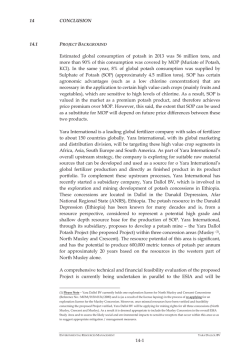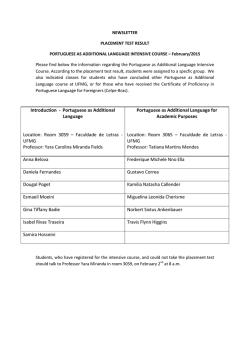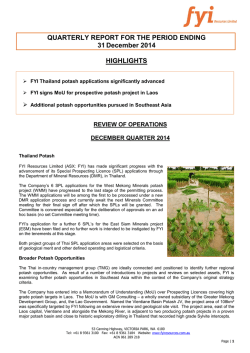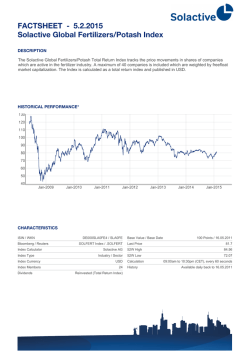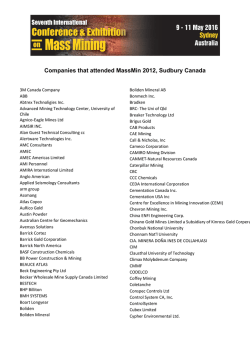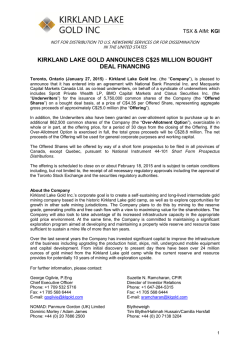
Non-Technical Summary— Draft Environmental and Social
Non-Technical Summary— Draft Environmental and Social Impact Assessment (ESIA) for the Proposed Yara Dallol Potash Project 1 INTRODUCTION This document represents the non-technical summary of the Environmental and Social Impact Assessment (ESIA) report for the proposed Yara Dallol Potash Project, located in the Danakil Depression of the Afar National Regional State in Ethiopia. This document provides a summary of: The project description; The findings of the ESIA; The expected environmental and social changes due to the Project; and The mitigation and management measures by Yara Dallol BV to reduce negative impacts and enhance positive impacts. Finally, the document provides interested and affected parties with the required information as to how and where they should provide their comments or questions on the document, should they wish to do so. PLEASE NOTE: The full ESIA report is available on the Project website – http://www.erm.com/Dallol-BV-Potash-Project-EIA PROJECT BACKGROUND Yara International is a leading global fertilizer company. As part of Yara’s business strategy, the company is exploring opportunities for suitable sources for use in its production process. Sulphate of Potash (SOP) is also known as potassium chloride (K2SO4) and is mainly used in the manufacture of fertilizer for agricultural purposes. Yara recently established an Ethiopian subsidiary, Yara Dallol BV, which is managing potash exploration in the Danakil Depression. Should exploration be successful, Yara Dallol BV propose to develop a potash mine, the Yara Dallol Potash Project (hereafter referred to as “the proposed Project”) to secure a source of potash to be used in the fertiliser manufacturing process. 2 PROJECT LOCATION The proposed Project site is (in a straight line) located approximately 590km north of Ethiopia’s capital Addis Ababa, and 330km north-east of Djibouti (refer map on the Page 4). PROJECT DESCRIPTION PROJECT PHASES In general, mining projects are developed in sequential phases illustrated in the figure below. The applicability of these phases to the proposed Project are discussed on Page 5. Exploration Operation Definitive Feasibility Study Construction Bridge Engineering Pre‐ construction Decommissioning and Closure 3 4 PROJECT DESCRIPTION (CONT). PHASE 1. Exploration PHASE 2. Definitive Feasibility PHASE 3. Bridge Engineering Study Yara Dallol BV’s exploration activities in the Danakil Depression began in February 2010. It included core drilling, sampling and pilot testing of wells for potash deposits as well as other specialised studies, such as hydrogeological studies, in order to determine the feasibility of the proposed project. The mineral resource estimate derived is a major component in the evaluation of the overall economic feasibility of the proposed Project. The results of exploration drilling activities to date have revealed an extensive source of potash. As a result, the proposed Project has moved from exploration to pre-feasibility and feasibility phases. In parallel to exploration activities, Yara Dallol BV commissioned engineering works and planning (including the engineering scoping study and definitive feasibility study) and the ESIA. These activities are currently underway and are being undertaken to determine how much it will cost to implement the proposed Project, including the costs of implementation of social and environmental mitigation measures determined by the ESIA. The definitive feasibility study and ESIA is end of January 2015. The preparation phase after the feasibility and before the start of construction is known as the bridge engineering phase. During this phase project activities on critical path and components are identified and actively managed to ensure that its implementation does not affect the overall project programme. The bridge engineering activities are anticipated to start in November 2014 and continue to November of 2015. PHASE 4. Pre-construction PHASE 5. Construction PHASE 6. Operation Pre-construction activities consists of the finalisation of engineering studies, bridge engineering activities, the receipt of a mining license, finalisation of agreements with the Port of Tadjoura, securing Project finance and the anticipated ESIA approval from the Ethiopian Ministry of Mines (MoM). Pending environmental approval of the ESIA from the MoM and finalisation of pre-construction activities, commencement of construction activities is scheduled for February 2016 and has a planned duration of approximately 30 months. Construction includes the installation of all Project related infrastructure, including the camps where the workers will be housed. Operation of the mine by solution mining method is scheduled for commencement upon final installation of Project infrastructure, scheduled for June 2018. The expected lifespan of the mine is approximately 20 years for the western half of the North Musley concession. Over all Mining activities will include the mining and processing of sulphate of potash. This is illustrated in page 5 overleaf. 7. Decommissioning and Closure The decommissioning and closure phase will start when all the potash has been extracted from Yara Dallol BV license areas. Decommissioning and closure involves the dismantling of mine infrastructure and the rehabilitation of disturbed land amongst a range of other activities. 5 SOLUTION MINING PROCESS Potash is located underground in the given concession areas and Yara Dallol BV proposes to use a mining method called “solution mining” to extract the potash from beneath the surface. The solution mining process is illustrated at the bottom of this Page: Mining Layout – between 450 and 500 caverns are proposed in this mining area (western half of the North Musley concession) over the life of mine (approximately 20 years). Between 35 and 45 caverns are estimated to be required to achieve an annual production rate of 600 kilotonnes per year (ktpy) of potash. The caverns will be between 80m and 270m below ground surface. Potash bearing brine will be produced in the caverns. Evaporation Ponds – from the caverns, it is proposed to pump brine to a series of solar evaporation ponds in which brine will be evaporated resulting in the crystallisation of potash bearing salts. Scrapers harvest crude potash from the evaporation ponds and this is transported to the processing plant. Processing Plant – at the processing plant, salts will be crushed and further refined. Some unwanted salts will result from this refinement process. These salts will be discarded to the Tailings Management Area or used to backfill mined out caverns. Water Requirements - the proposed Project will require large quantities of water with different quality requirements depending on the use. The average Project water consumption is 1,550m3/h for the duration of mining (approximately 20 years). Electricity Requirements - Electricity will be sourced from Ethiopian Electric Power (EEP) during the operational phase of the proposed Project. EEP is planning on constructing a 230kV electrical grid The Solution Mining Flow Diagram 6 REQUIRED PROJECT INFRASTRUCTURE The proposed Yara Dallol Potash Project will require the following site infrastructure: Plant, machinery and equipment as required; Construction of access roads to, from and inside the Project Area; Water wells for use during the production phase; A water and potash-bearing brine pipeline network to transport the brine solution within the Project Area; Wellfield infrastructure, including a blanket oil tank and oil / water separators; Evaporation ponds where the water will evaporate leaving the potash-bearing salts behind; A processing plant to produce the final potash crystals; A Tailings Management Area for the storage of excess material from the processing process; and Staff living quarters. In addition to the above mentioned site infrastructure, the proposed Project will require the following ancillary / support infrastructure: Road transportation route to and from the mine site to a Port in Tadjoura, Djibouti (the port is currently being constructed); Driver resting and exchange areas, proposed at the town of Serdo near Semera and the Tadjoura Port; and Facilities at the port in Tadjoura for exporting potash. ROAD TRANSPORTATION ROUTES Yara Dallol BV will be transporting the potash product by road, using 60 tonne gross vehicle weight trucks. It is anticipated that 96 trucks will be moving on the roads per day transporting potash product; this includes 48X product loaded trucks travelling from the Yara Dallol Potash Project Site and the port in Tadjoura and 48X empty trucks travelling from the port in Tadjoura through to the Yara Dallol Potash Project Site. Two alternative transport routes were identified by Yara Dallol BV for use during the construction and operations phases. LONG-TERM OPERATIONS ROUTE The route proposed for the haulage of potash runs south from the Yara Dallol Potash Project Site past the settlement of Hamad Ela, and along a new government planned road through the Danakil Basin. The proposed road joins the existing road about 20 km north of Afdera and continues south to the proposed new border crossing at Balho and then onto the proposed port in Tadjoura, Djibouti. This is illustrated overleaf (Page 8). 7 8 REQUIRED PROJECT INFRASTRUCTURE (CONT.) DRIVER REST STOPS IN SERDO AND PORT OF TADJOURA The potash product trucks will drive from the Project Site to the Port of Tadjoura and the total journey will take approximately 16 hours (including a 2 hour break). During the trip the drivers will change over to make sure they get enough rest. To support this there will be a truck-stop facility built near Serdo. STAKEHOLDER ENGAGEMENT PROCESS The Stakeholder Engagement process consists of five phases all of which are an integral part of the ESIA process as indicated in the Figure below The process is currently in the draft ESIA phase. The objective of the stakeholder engagement process during the draft ESIA phase is to collect questions and comments regarding the proposed Project and the expected changes resulting from it. During this project phase, engagement will take place with federal, regional and local level stakeholders as well as with experts who can comment meaningfully on the impact assessment and proposed mitigation plans. We are currently here ON‐GOING STAKEHOLDER ENGAGEMENT The draft ESIA report structures the findings of the study as set out below: The likely changes to be expected as a result of the proposed Project; An impact prediction of who or what will be affected and how significant the impacts will be; and The proposed mitigation plans on the management of the impact in order to minimise negative impacts and enhance positive impacts. 9 SOCIAL AND ENVIRONMENTAL SENSITIVITIES The figure below, presents the biological and social (including the presence of villages, cultural heritage sites, key resource areas, etc.) sensitivities within the Project Area. The map is created as a tool to guide the proposed Project in a manner that minimises impacts to both the social and biological environments. The following simple approaches should be followed for the planning of activities/infrastructure: Activities/infrastructure should be directed wherever possible towards the Low Sensitivity areas. Activities/infrastructure that encroach areas classified as being Highly to Moderately Sen- sitive should strive to reduce the impacts on these areas that resulted in the sensitivity rating. Activities/infrastructure are to be planned and implemented in a manner that keeps the key values of Highly Sensitive areas. Activities/infrastructure should not encroach areas classified as being Highly Sensitive. Only where no feasible alternatives exist should any impacts be allowed on these habitats, and in such cases additional management measures should be taken that reduce the impacts. EXPECTED CHANGES FROM THE PROPOSED PROJECT This Section identifies and describes the key social and environmental impacts of the proposed Project on the area immediately surrounding the Project site. The findings are presented in a table format according to the following categories: Impact description. Impact assessment (with an assessment scale ranging from either minor, moderate or major positive or negative impacts). Mitigation measures to achieve avoidance or minimisation of negative impacts and en- hancement of positive impacts. Residual impacts remaining after mitigation measures were implemented. 10 11 PLEASE NOTE: The impact description and assessment in the Table overleaf describes and assesses the impacts to the physical, biological and social environments both without and with the mitigation measures being proposed in this ESIA. It should be noted that Yara Dallol BV is committed to the implementation of these mitigation measures, as proposed. Further, the Table overleaf presents the impacts after mitigation, known as residual impacts . Moreover, the impacts and mitigation plans presented in the Table may change after they have been presented and discussed with stakeholders, based on their suggestions and feedback. 12 Table 1.2 STUDY Summary of the draft Impacts Assessed IMPACT Assessment of Water Impacts & Mitigation (Chapter 10 Section 10.2 and 10.3) Abstraction of large volumes of groundwater to be used in the mining process. An estimated 650m3 per hour of fresh water and approximately 870m3 per hour of salty water will be needed in the solution mining process. This water is used by some local communities (such as Musley and Asabuya) and by local plants including palms, along the salt pan edges. Although deemed unlikely following studies undertaken on groundwater in the Project area, the pumping of water may decrease the amount of water available to plants and the communities of Musley and Asabuya. No surface water will be affected by the proposed Project. ASSESSMENT Major Significant Negative Impact MITIGATION/MANAGEMENT RECOMMENDATIONS It is unlikely that the Yara Potash Project will result in drawdown of water; however, Yara Dallol BV will monitor ground water levels to see how quickly the ground water level decrease due to pumping and how quickly the ground water levels increase from movement of water underground as a result of rains in the highlands and mountain areas. Yara Dallol BV will monitor the health and status of palms in relation to the amount of water being pumped out for the Project. Yara Dallol BV will monitor the numbers of fish identified in ponds located on the salt pan edges in relation to the amount of water being pumped out for the Project. Yara Dallol BV will only pump an amount of water from underground that is equal to the amount being replaced by rains from the highland areas. The proposed Project water supply well field should be designed in a way that minimises groundwater drawdown and impacts to people and plants. Yara Dallol BV will also monitor community water levels and if water levels decrease due to Yara Dallol BV’s activities they will provide alternative sources of drinking water. Yara Dallol BV will train some members of the community to understand the results from monitoring and communicate these to other residents. Yara Dallol BV will work together with other solution mining companies and federal (Ministry of Water, Irrigation and Energy), regional (Bureau of Water Resources) and local level governments to develop a RESIDUAL IMPACT Moderate Significant Negative Impact STUDY IMPACT ASSESSMENT MITIGATION/MANAGEMENT RECOMMENDATIONS RESIDUAL IMPACT regional monitoring system to ensure that an early warning system exists should over abstraction of groundwater take place. Blocking surface water run-off from reaching vegetation during flooding events due to construction of surface infrastructure without proper drainage designs in place. This may result in vegetation dying. Minor to Moderate Significant Negative Impact Yara Dallol BV will place culverts in areas where flood water normally runs in order to ensure that the palms and other plants continue to get the water they need. Negligible to Minor Significant Impact The additives to the water to enable solution mining may result in the contamination or pollution of groundwater. Minor Significant Negative Impact Yara Dallol BV will have a Spill Prevention, Control and Containment Plan which will detail the process to be followed in case of a spillage or contamination. This plan will also include information on how to carefully work with oils and fuels so that the environment is not contaminated Negligible Significant Negative Impact Yara Dallol BV will manage the sewage treatment system in a manner that results in no release of raw sewage into the environment. Yara Dallol BV will monitor groundwater to see if the Project has impacted on groundwater quality at least every three months. Yara Dallol BV will deposit excess salt onto unpaved roads and apply speed limits to slow down vehicles and reduce the amount of dust generated. Wherever possible the size of disturbed areas during construction will be minimised and soil stockpiles will be managed to control the amount of dust generated. Assessment of Air Quality Impacts & Mitigation (Chapter 10 Section 10.4) Polluted groundwater due to inadequate management of sewage. Increased dust pollution during construction and decommissioning phases due to increased construction traffic on unsurfaced roads. This impact could potentially affect the social and natural environment for as far as five kilometres from the site and access roads. Major Significant Negative Impact Negligible to Minor Significant Negative Impact Assessment of Biological Environment Impacts & Mitigation (Chapter 10 Section 10.6) Assessment of Noise Impacts & Mitigation (Chapter 10 Section 10.5) STUDY IMPACT ASSESSMENT MITIGATION/MANAGEMENT RECOMMENDATIONS RESIDUAL IMPACT Increased dust pollution during operational phase due to 96 trucks generating dust on a daily basis between the mine and Tadjoura Port on unsurfaced roads. This will impact on sensitive receptors such as households, located close to the road. Negligible Significant Negative Impact Yara Dallol BV will maintain their vehicles in good running order and will use enclosed trailers to transport potash. The entire transport route will be paved prior to use for export of product; however, if it is not all paved then any unpaved sections will be treated (i.e. by the placement of excess salt) to reduce the amount of dust generated. Negligible Significant Negative Impact Increased air pollution levels due to emissions by the diesel generated emergency power supply plant. N/A The emergency generators will only be used during downtime of the EEP power supply. N/A Yara Dallol BV will maintain their generators according to the specifications, thereby reducing emissions to the air, and will use diesel fuel available in Ethiopia with the lowest possible sulphur content. Yara Dallol BV will monitor noise levels, avoid excessive noise generating activities and where noisy activities need to be undertaken in close proximity to camps or villages they will be carried out in a way that reduces the amount of noise generated. Increased noise pollution during construction and operational phases due to noise generated by construction plant and vehicles. Negligible Negative Significant Impact (local villages) There are two types of sensitive receptors to noise namely the nearby military camp and local villages. The military camp is situated close to the proposed site and will potentially be more affected by increased noise pollution. Local villages will be much less influenced as they are located further from the site. Major Negative Significant Impact for military camp and nearby settlers (at night time) Although deemed unlikely following studies undertaken on groundwater in the Project area, drawing down the natural level of the groundwater table due to Yara Dallol BV’s proposed abstraction of groundwater for construction and operational purposes may take place. This may result in a negative impact on fauna and flora in the area that are dependent on the groundwater resource for survival. Impact on or destruction of sensitive habitats due to the construction of Project infrastructure on fauna and flora on the Project site. Major Negative Significant Impact Yara Dallol BV will monitor changes to the palms / fish ponds; if Yara Dallol BV realise any negative changes to the palms or fish ponds, they will establish measures to compensate for these negative changes. Such measures could include artificial cultivation of palms and maintenance of fish ponds. Moderate to Major Negative Significant Impact Minor Significant Negative Impact Where possible Yara Dallol BV have avoided all sensitive habitats, which were identified during the early stages of the ESIA study. In addition they will implement a biodiversity management plan that controls potential impacts to plants and animals; this will mean that infrastructure is grouped to avoid impacts, staffs are Minor Significant Negative Impact Whenever Yara Dallol BV undertakes work that will cause excessive noise, they will make sure that they tell communities’ likely to be impacted, of the dates when the noise will occur, and will ensure that these activities are undertaken at a time that least affects these communities. Negligible Negative Significant Impact (local villages) Minor Negative Significant to Negligible Negative Significant Impact (local villages) STUDY IMPACT Injury or death to fauna in the Project area due to collisions with construction or mine vehicles. ASSESSMENT Moderate Significant Negative Impact MITIGATION/MANAGEMENT RECOMMENDATIONS Scaring of fauna in the Project Area due to increased traffic and noise levels by Project plant and vehicles. suitably trained and all disturbed areas are suitably rehabilitated at the decommissioning phase of the Project. To minimise impacts on animals in the area, Yara Dallol BV will: - - Assessment of Social- Impacts & Mitigation (Chapter 11 Sections 11.2 to 11.10) - Increased employment creation in the project area as a result of an estimated 1,000 employment opportunities during construction and 800 during operations. Positive Local jobseekers will be given preference and only if the required skills and experience are not available locally, will workers be imported from elsewhere in the country. Improved levels of skills as a result of proposed skills training programmes for the labour force. Positive Pipelines and roads will include facilities that allow the underpass or overpass of animals. The evaporation ponds will be designed to minimise their attraction to water birds. This will be achieved by minimising the shoreline of the ponds. Birds like to congregate along the shores. Non-lethal bird scare tactics can also be used at the evaporation ponds. Where possible, Yara Dallol BV will maximise the opportunity for local people to benefit from these direct and indirect jobs. Yara Dallol BV will set targets for local hiring and seek to use local businesses and services as far as possible. Yara Dallol BV will provide all its Contractors with the requirements related to hiring for inclusion in tendering documents including aspirational hiring targets, auditing arrangements, and (where relevant) training requirements. Yara Dallol BV will also engage with locals about job opportunities recognising that many of the skills required may not be available in the local area. An internal Yara Dallol BV 'certification' or reference letter will be provided to those who have successfully Minor Significant Negative Impact Ban its workers from killing any animals for eating or other purposes; Limit the amount of artificial lighting used; All new workers will be told of the types of animals that have been seen in the area during their induction programmes; There will be an animal rescue programme in place to help any animal that has been hurt because of the project; and Will enforce speed limits on the roads used by its vehicles. RESIDUAL IMPACT Positive Positive STUDY IMPACT ASSESSMENT MITIGATION/MANAGEMENT RECOMMENDATIONS RESIDUAL IMPACT completed all training provided and to assist any retrenched employees/ or those at the end of the contract work to get employment elsewhere. Selection for employment during the operational phase resulting in more skills training opportunities. For operational jobs, training plans will be developed according to each permanent employee’ work agreement and relevant to their job description. Yara Dallol BV will establish hiring offices in one or more of the largest settlements where people can register themselves on the employment database. Yara Dallol BV will develop a plan for buying equipment//materials needed by the Project at the beginning of construction. This plan will focus on buying most of the necessary items in the local area, Afar region or elsewhere in Ethiopia, recognising that many of the goods needed are not available in the local area currently. Government will make their own decisions regarding how to best use the moneys paid to them by Yara Dallol BV. Increased local, regional and national procurement of required machinery, equipment and materials. Where items are not available in-country, it will be sourced internationally. Positive Increased revenue for the Federal, Regional and Local government due to income generated by the mine development. Positive Increased in-migration of employment seekers due to the establishment of the mine. This will result in increased spending on basic items such as food and other services. Major Significant Negative Impact Yara Dallol BV will monitor food prices to see if prices are rising. Yara Dallol BV will work with the government to try and stabilise the food prices in the area as well as make sure that emergency food aid is delivered on time. Moderate Significant Negative Impact Positive and Negative Significant Impacts Yara Dallol BV working with government will develop and implement in-migration management plans which will assist in the monitoring, controlling and management of in-migration to the area. Positive and Negative Significant Impacts Increase in local food and service prices due to the increased demand and a possible shortage of supply. Influx of people coming from outside the region due to the increased economic activity. This may result in positive and negative changes in the social fabric and dynamic of the local community. Positive Positive STUDY IMPACT ASSESSMENT Changes to the social dynamics and pervasive culture in the project area due to the influx of people from outside the project area. This can be perceived as positive and negative by the local population. Resentment, conflict and possible violence against newcomers into the project area in the event that local people develop the opinion that newcomers receive more benefits from the project than what they do. Major Significant Negative Impact MITIGATION/MANAGEMENT RECOMMENDATIONS Yara Dallol BV will engage government, and local communities/ people to discuss the issues, risks, threats, and opportunities linked to more people moving into the area. Regular studies will be undertaken to understand the increases in people moving into the various large settlements, and relationships between migrants and locals, as well as any problems arising because migrants in these areas. Yara Dallol BV will publicly inform people about any upcoming job opportunities through the employment office so as to discourage people moving to the area. Yara Dallol BV will work with and assist local authorities in planning for the provision of waste management and drinking water facilities to meet the needs of the expanded population. Working in conjunction with relevant partners (e.g. health authorities, Non-governmental Organisations, development agencies), the Project should develop information and awareness campaigns around diseases and health practices related to sanitation and hygiene. Working with Project affected communities and local authorities Yara Dallol BV will support village zoning to assist in protecting land-based resources of importance to biodiversity and cultural heritage. Yara Dallol BV will implement an integrated capacity building programme to help provide opportunities for local authorities and village communities to plan, prioritise, build and maintain necessary infrastructure. To manage its workforce, Yara Dallol BV will teach its employees about the Afar culture and traditions as well as emphasise the importance of respecting the culture and its people. Yara Dallol BV will also develop a code of conduct for its workers to emphasise that they should not interfere with the cultures and traditions of the Afar people. RESIDUAL IMPACT Minor Significant Negative Impact STUDY IMPACT Increased infection of local people by in-migration of carriers of diseases such as HIV/AIDs and TB may result in an increased prevalence of these diseases. Increased levels of anti-social behaviour such as alcohol abuse, prostitution, violence and drug use (including that of khat) due to an increased availability of expendable income. ASSESSMENT Major Significant Negative Impact Moderate Significant Negative Impact MITIGATION/MANAGEMENT RECOMMENDATIONS Through the complaints procedures that will be in place, local people will be able to report to Yara Dallol BV if its workforce or migrants in the area are being disrespectful and Yara Dallol BV will investigate. Yara Dallol BV will support inter-village sport and recreational competitions to foster a sense of community within villages and healthy competition between villages. Yara Dallol BV will also try and use traditional Afar conflict resolution methods when a dispute occurs between its workforce and locals. Yara Dallol BV will work with local, regional and federal partners to prevent diseases and make sure there are facilities to treat them. Yara Dallol BV will work with these partners on developing a communication system to inform leaders and partners if there is an outbreak of diseases. Yara Dallol BV will test all their workers before and during their employment at Yara Dallol BV, to check that they are fit for work. In this way they will identify and be able to treat diseases the workforce may have, thus reducing the chance of disease spreading to the community. Yara Dallol BV will have a programme to prevent HIV in the workplace and community. Workers will be trained on health and safety and be made to agree to strict rules to prevent spreading sickness and sexually transmitted diseases. Yara Dallol BV will partner with the local Government, community leaders and NGOs to raise awareness around the dangers and consequences of substance abuse, violence and others. Yara Dallol BV will ask local leaders, authorities and residents what kind of behaviour they would like from non-local Yara Dallol BV workers. This information will be used to develop a set of rules which Yara Dallol BV employees will need to follow. RESIDUAL IMPACT Minor to Moderate Significant Negative Impact Minor Significant Negative Impact STUDY IMPACT Increased road traffic may result in death or injury to people and livestock. The communities of Hamad Ela, Berahale, and Serdo will be particularly vulnerable. Disturbance to or possible destruction of cultural heritage sites and places of historical importance due to construction or mining activities. ASSESSMENT Major Significant Negative Impact Moderate to Major Significant Negative Impact MITIGATION/MANAGEMENT RECOMMENDATIONS Yara Dallol BV will ensure that their workers agree to good behaviour and will penalize bad behaviour. Yara Dallol BV will keep the construction workers away from local villages. Yara Dallol BV will develop and implement a Traffic Management Plan for its own drivers that provide specific traffic calming measures. Yara Dallol BV will implement a road safety awareness campaign throughout the route of the proposed road to the Port of Tadjoura (Djibouti) to improve community knowledge of the dangers of industrial road traffic and safe behaviour in and around roads, especially amongst school children. All Yara Dallol BV drivers will be given extra training to further improve their driving skills. In cases of emergencies, Yara Dallol BV will develop an emergency response plan which will detail what drivers should do when they are in an accident. Through the complaints procedures that will be in place, local people will be able to report to Yara Dallol BV causes any issues or concerns. Some cultural heritage sites have been identified that are very important. Yara Dallol BV will try and avoid any changes in these areas. If these areas can’t be avoided, then Yara Dallol BV will work with local, regional and federal authorities to make sure that the disturbance is managed in a way that will be acceptable to the local people. Although there are no known sites, it is possible that such sites may be unearthed during the construction process. Disturbance, vandalisation or destruction of cultural heritage sites by incomers into the area due to a lack of knowledge or respect for heritage artefacts and customs. Heavy loaded trucks often cause light vibrations as they pass through an area and with time they might cause disturb the above ground cultural heritage resources in Negligible to Major Significant Negative Impact Yara Dallol BV’s workers will be trained so as to understand local cultural sites and to avoid them. Yara Dallol BV will also have a procedure in place (for cases when an object of cultural heritage importance is found where none were predicted). The procedure will have details of how to proceed when something of importance has been found. Yara Dallol BV will enforce speed limits for their own vehicles in areas of known sensitive cultural heritage RESIDUAL IMPACT Moderate Significant Negative Impact Minor to Moderate Significant Negative Impact Negligible to Major Significant Negative Impact STUDY IMPACT ASSESSMENT MITIGATION/MANAGEMENT RECOMMENDATIONS close proximity to the roads resources (situated in the Project Area) in order to avoid/limit any potential damage that may be caused by vibrations. Visual impact changes to the landscape caused by construction of new infrastructure. Minor to Moderate Significant Negative Impact Unsafe and unhealthy working conditions particularly due to high ambient temperatures in the project area. Moderate Significant Negative Impact Unpleasant or unsafe working and living conditions for the labour force. Possible conflict and labour unrest due to lack of knowledge about employment conditions and legislation. RESIDUAL IMPACT Even with a reduced speed limit, vibrations from vehicle traffic could still occur; as such Yara Dallol BV will monitor the known cultural heritage site for signs of damage. Yara Dallol BV will design the Project so that it does not significantly impact on the visual landscape, especially from important places like Mount Dallol. This will be done by using special materials and colours that blend into the background, by using lighting that shines downwards, by not permitting fires and by reducing dust emissions. Yara Dallol BV will be careful in ensuring lights are not directed towards communities. In addition, the site will be kept neat, with the orderly storage /parking of materials and equipment, and will keep the site and access roads free of litter. Yara Dallol BV will be very strict with workers to make sure that they work in a safe way to avoid any injuries or illness. This will involve training, monitoring and giving workers an opportunity to raise issues or concerns through a grievance mechanism. Yara Dallol BV will also provide all of its workers with the necessary equipment to protect themselves from accidents while working, for example hard hats and safety glasses. Yara Dallol BV will ensure that the workers’ accommodation will be of a very good standard, according to international best practice. Yara Dallol BV will monitor this and will also have policies that promise to make sure workers work in a fair environment. Yara Dallol BV will work with workers to solve problems. Yara Dallol BV understands the limitation of local people regarding labour laws as such they are planning to do the following: - Ensure that all employment contracts (for the locally Minor to Moderate Significant Negative Impact Negligible Significant Negative Impact STUDY IMPACT ASSESSMENT MITIGATION/MANAGEMENT RECOMMENDATIONS sourced workforce are translated into the local languages). - Employment department will sit with each worker and explain their contract and job requirements before signing for proper understanding. - Provide the workers with basic information on the labour laws of the country. - Yara Dallol BV will also have workforce grievance procedures where the workers can formally raise issues and concerns for Yara Dallol BV to investigate and address accordingly. RESIDUAL IMPACT 23 REGISTRATION AND COMMENT SHEET To register and provide comments please contact: Miss. Janet Mkhabela ERM Mr. Samuel Hailu TS Environmental Email: [email protected] Email:[email protected] Tel: + 27 (0) 21 681 5400 Fax: + 27 (0) 21 686 0736 Tel: +251 (0) 911 373 167 Fax: + 251 (0) 116 623 732 Thank your for your participation 24
© Copyright 2025
